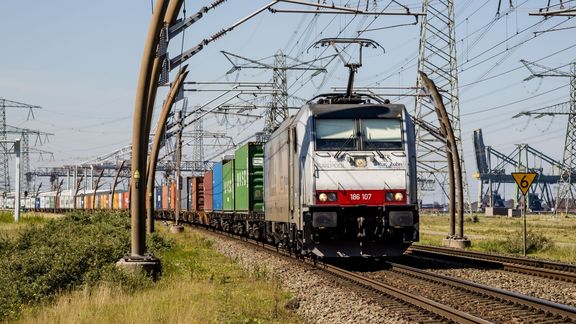New boost for Dutch rail freight transport
Chain parties reach agreement regarding package of incent | Various parties active in the rail freight transport sector have reached agreement with State Secretary Stientje van Veldhoven about an incentives package that is intended to make rail freight transport even more sustainable and attractive. Among other things, the agreement concerns various measures regarding the substantial reduction of the usage charge, adaptation to the European railway safety system ERTMS and the improvement of the everyday surroundings of people in the vicinity of the rail network.

The incentives package will encourage a modal shift, meaning that it is in line with the climate targets and the Dutch government’s coalition agreement.
The package was adopted in consultation with the rail freight round table. Shippers, rail operators, terminals, ports, railway infrastructure companies, ProRail and the Ministry of Infrastructure and Water Management come together in this platform to confer about the future of rail transport.
State Secretary Van Veldhoven: “Our economy is doing well, which has also led to an increase in freight transport by rail. The participants in this round table work to ensure that as many of these freight streams as possible are directed via rail. This removes pressure on the roads and furthermore results in a smaller environmental footprint. Today, we have taken a major step forward by translating our joint goals for the near future into a single package.”
The incentives package contains financial and technical solutions for freight transport by rail. A few examples:
• Every year, an amount of 12 to 14 million euro in funding will be made available in the period until year end 2023 that enables a sizeable reduction of the usage charge – bringing the costs to a level comparable with that found in Germany (the impact of the measure will be evaluated in 2021).
• It will be examined which adaptations could allow operators to deploy longer trains – to a maximum length of 740 metres.
• In the context of the implementation of the new rail security system ERTMS, the government will work to take advantage of national and European funding and shape the complex transition toward ERTMS in such a way that it creates the right conditions for the healthy growth of freight transport by rail.
• The parties will work together to increase the efficiency of rail freight transport in port areas, use quieter rolling stock and hybrid locomotives and examine which options there are to introduce low-vibration bogies.
Through these and other measures, the members of the rail freight round table aim to increase the volume of freight transport by rail from 42 million tonnes in 2016 to 54-61 million tonnes by 2030.
Chair of the rail freight round table Steven Lak: “This package of incentives marks the start of a whole new approach. It is incredibly important in this context that all parties involved in the rail sector keep their shoulders to the wheel and keep working together. I have seen huge willingness among all the participants, and this package of incentives will give major impetus to freight transport by rail.”
The incentives package will be worked out in further detail within the rail freight round table in the months ahead. The House of Representatives was informed in writing today of the contents of the package.